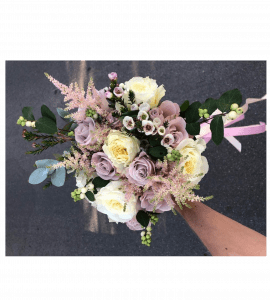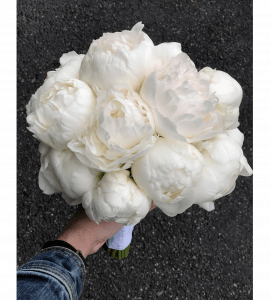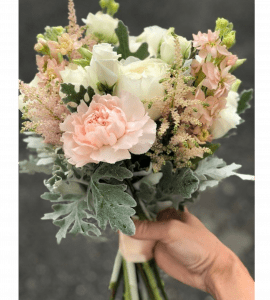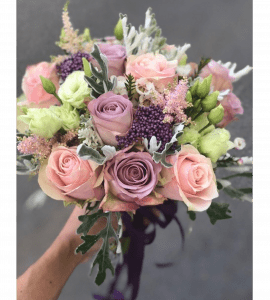A wedding bouquet is one of the main symbols of marriage: throughout the solemn day, it complements the image of the bride and emphasizes her beauty, and at the end of the holiday, the newlywed symbolically leaves a neat armful of flowers, giving it to an unmarried girl as a gift. Instead of entrusting the creation of this important attribute of a celebration to a florist, you can make a bouquet yourself: this way you will be sure of the freshness of the flowers and fill the composition with your own love. We suggest you try to create the perfect wedding bouquet yourself based on a simple master class.
Before you start creating a floral masterpiece, decide what it should be. Modern floristry distinguishes between such wedding bouquets:

Creation of glamelia, casada or structural bouquet requires skill and experience, both practical and theoretical: you need to be able not only to securely fix the flowers in the composition so that the bouquet does not disintegrate right at the altar, but also to know how the plants will behave in this case during the day. If the bride’s choice fell on one of these bouquets, it is still better to entrust their creation to a florist.
At home, the easiest way is to make a Biedermeier, a classic round or semicircular composition: everything you need to create these bouquets can be purchased in flower shops at a low cost. And since the wedding bouquet should still be perfect, it is better to buy the materials necessary for its collection with a margin: even if you cannot assemble the dream composition the first time, thanks to the supplies of materials, you can try to do it again.
To create a wedding composition, flowers are chosen that match the style of the wedding, the details of the outfits of the bride and groom and the palette of the event as a whole. Most often, weddings are decorated in gentle colors, close to white or pastel. At the same time, bouquets can either consist of buds of discreet shades, or have bright accents, set off by more restrained background plants.
A variety of shades and varieties of the listed plants allows you to create any composition, from muted gentle to extravagantly bright. The bouquets include buds of different sizes, and also necessarily dilute the composition with greens (palm leaves, eucalyptus or ferns), background plants with small inflorescences (gypsophila or chamelacium) and berries (hypericum or brunia).
Succulents look spectacular in wedding compositions: echeveria, crassula and fat woman. The advantage of these plants over the others lies in the special structure of the leaves that retain moisture in the flower. Thanks to this, a bouquet with succulents will retain a lively appearance even on the hottest day, and after the end of the celebration, these flowers can be planted in a pot, thus preserving the memory of the wedding day for many years.
To create a classic Biedermeier, round or semicircular composition, you will need the following materials:
You can start working on the bouquet a few days before the ceremony – this will hone your skills by creating, if necessary, a “rough” version of the composition. To keep the plants fresh until the desired day, use professional floristic products for feeding flowers and disinfecting the water in which the bouquet will stand.
Before starting to work with the bouquet, immerse the floral sponge in a container of water. Let it sink passively to the bottom of the vessel: this will mean that the oasis is full and ready for use. Any active attempts to speed up the process will either damage the oasis or soak only the upper layers of the sponge with liquid, so that the plants immersed in it will not receive moisture and will quickly wither.
Collecting a composition with a bouquette holder begins with filling its handle with hygroscopic material (for example, paper), thanks to which the flower stalks will securely hold inside the structure. After that, fix the oasis soaked in moisture in the upper part of the bouquette holder, firmly fixing the sponge with a wire.
Decorate the edges of the frame with decorative greenery to hide the plastic parts and wires (for example, overlapping). Already at this stage, the lower part of the bouquette holder can be decorated with a satin ribbon, lace or other decor using a heat gun and glue.
Let’s start immersing the plants in the oasis: to do this, cut their stems to about 6 cm with a sharp knife and immediately stick the flower into the sponge. Arrange the buds evenly by rotating the bouquet in a circle. Start with the largest flowers, then place the middle ones and only then the smallest ones. Try to keep the flowers as close to each other as possible, but be careful not to wrinkle the buds. At the very end, add greenery and decor to the bouquet.
Stylish wedding bouquets can be made without a portbouquet holder: to do this, wrap the stem of each flower with tape, stepping back about 3 cm from the bud, and then wrap the resulting leg of the assembled composition with satin ribbon or lace. A wire frame can be placed in the thickness of the leg, consisting of individual stems wrapped in tape. Remember to cut the stems of such a bouquet to the same length to make the composition look neat.


